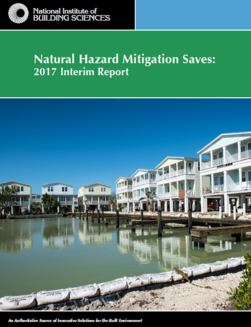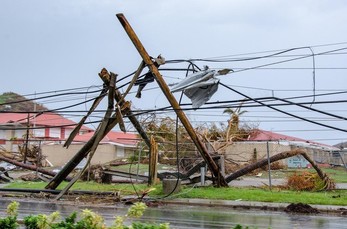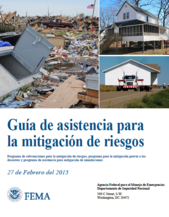|
2017 Interim Report

Last week, the
National Institute of Building Sciences (NIBS) Multi-Hazard Mitigation Council
(MMC) released an updated and expanded Natural
Hazard Mitigation Saves: 2017 Interim Report.
In this new report, NIBS MMC examined 23 years of federal
grants data to determine the benefits we derive from avoiding damages through
activities funded with federal grants, and examined an expanded set of
mitigation actions to determine the Benefit Cost Ratios (BCR) of building new
structures beyond code requirements. The hazard categories covered in this
report include: Riverine Flood,
Hurricane Surge, Wind, Earthquake, and Wildland-Urban Interface Fire (WUI).
The new report uses two high-level Benefit Cost Ratios
(BCRs) representing the benefits of mitigation. The report results indicate
mitigation grants funded through select federal government agencies, on
average, can save the nation $6 in future disaster costs, for every $1 spent on
hazard mitigation. The report also demonstrates that, on average, investments
in hazard mitigation measures that exceed provisions of the 2015 model building
code can save the nation $4 for every $1 spent.
|
National Mitigation
Investment Strategy Public Comment Period Open
For our nation to become more resilient, we must develop a
more effective and efficient way to invest in mitigation. The U.S. Department
of Homeland Security tasked the Mitigation Framework Leadership Group (MitFLG)
to develop a National Mitigation Investment Strategy (Investment Strategy). The
MitFLG invites ideas about investment from all levels of government and key
stakeholders, including private businesses, citizens, vulnerable and at-risk
populations, critical infrastructure sectors, and non-profit, academic, and
philanthropic organizations.
The public comment period on a National
Mitigation Investment Strategy (Investment Strategy) is now open.The draft Mitigation Investment
Strategy makes a series of recommendations, which – if met – could result in a nation better equipped for, and less
vulnerable to, natural hazards.
The draft Investment Strategy is
available on the National Mitigation Framework website at https://www.fema.gov/national-mitigation-framework.
Comments on the draft Investment Strategy will be accepted from January 11
through March 11, 2018 either through email to fema-nmis@fema.dhs.gov or through
IdeaScale at: https://fema.ideascale.com/a/ideas/recent/campaign-filter/byids/campaigns/60968.
Back to Top
Puerto Rico and U.S. Virgin Islands
Nearly
five months after Hurricanes Irma and Maria made landfall in the Caribbean,
hundreds of FEMA staff continue to focus effort on hazard mitigation in Puerto
Rico and the U.S. Virgin Islands.
Puerto Rico
By mid-December 2017, 141 mitigation staff members remained dedicated to the Puerto Rico response and recovery effort. Though they had provided information to nearly 59,000 residents at 28 separate Disaster Recovery Centers, the magnitude of destruction caused by the storms left Puerto Rico unable to transition from response to recovery until late-December.
At that time, between 20,000 and 30,000 structures were still awaiting inspection for a substantially damaged determination.
Exactly three months prior, Puerto Rico was struck by Hurricane Maria as residents still in the process of recovering from Hurricane Irma - which had made landfall a mere two weeks prior - were devastated by the second storm’s arrival.

(Photo: Puerto Rico - Reservist Doris Maldonado, along with a
Surge Capacity Force member and a local hire, discuss hazard mitigation to a
group of survivors.)
The impact of both storms caused widespread loss. For
example, nearly 30 dams on the island released water and flooded towns with
more than 25 inches of rain in some areas.
Despite the region not having had to rebuild after a storm
of this magnitude in 85 years, mitigation specialists are working to expedite
recovery. One way is to utilize grants with specific funding limits that were
piloted under Section 428 of the Stafford Act -- the Alternative Public
Assistance Program -- after Hurricane Sandy.
These Public Assistance grants combine multiple projects,
assess the required work and determine an overall, recovery budget, thereby
eliminating the need to do a Project Worksheet for individual projects. This
will decrease the number of necessary grants in Puerto Rico from somewhere in
the thousands, to a range of 125-140 grants. Priorities for mitigation efforts
in Puerto Rico include communication restoration and public infrastructure.
Some of the initial grants will be used to hire and
train building code enforcers to ensure structures are reconstructed according
to or above local code, and are better able to withstand future disasters.
Additional
mitigation efforts include hiring 50 to 60 local engineers and approximately 40
local architects to assist in recovery efforts.

U.S. Virgin Islands
Since Hurricanes Irma and Maria made landfall in the U.S.
Virgin Islands during late summer 2017, 75 mitigation staff have assisted
nearly 39,000 survivors at eight Disaster Recovery Centers.
Most residents came to these centers seeking advice on mold
remediation and home repair.
Field team members informed citizens of the dangers of mold
and mildew to the respiratory system and how to properly remove both from
homes. A publication titled Protecting
Your Home from Flood Damage — available in English and Spanish — was
especially valuable to Mitigation Specialists when counseling applicants on
mold and mildew cleanup. Information is provided by the Center for Disease
Control (https://www.cdc.gov/mold/cleanup.htm), Environmental Protection Agency (https://www.epa.gov/mold/mold-cleanup-your-home), and the Territorial Department of Health.
Team members also administered educational information on the
benefits of both Flood Insurance and Disaster Assistance. Information and
guidance was also provided on the process of selecting qualified contractors to
assist in repairing houses.
(Photo: St. Thomas, USVI, Sep.15, 2017- Downed trees, snapped
utility poles and debris are evidence of the powerful winds from Hurricane
Irma. FEMA/Photo by Kenneth Wilsey)
|
Back to Top
FEMA’s
Hazard Mitigation Assistance (HMA) Division invites you to a webinar on Thursday,
January 25, 2018, at 2 p.m. EST to share information on the American Society of Civil
Engineers (ASCE) 24 Building Codes for Mitigation.
Presenters
will provide information on ASCE 24 flood-specific building code requirements
as they relate to Hazard Mitigation Assistance. This will include information
about mitigation projects such as elevations, floodproofing, and mitigation
reconstruction. Participants
who would find value in this webinar include floodplain administrators, city
and building code officials, insurance adjusters, and others who have an
interest in understanding and applying ASCE 24 requirements. The webinar will
be followed by a question and answer session and links to valuable resources.
Title: Building Codes for Mitigation: Using ASCE 24
Date: Thursday, January 25, 2018
Time: 2:00 – 3:00 p.m. EST
Conference
Number(s): 1-800-320-4330 Participant
Code: 338559
Adobe Connect:
https://fema.connectsolutions.com/asce24-mitigation/
Be sure to test your Adobe Connect connection prior to the meeting.
Back to Top

Over time, FEMA has partnered with state emergency
management officials to constantly improve the standards for building
structures that can withstand the forces of Mother Nature.
Check out this
this video published in November 2017, titled “The Evolution of Mitigation,”
which highlights the value of mitigation during recent disaster events in the
Florida Keys.
|
Back to Top
In November, the Small Business Administration (SBA)
provided general information on loans designed for individuals and businesses
to conduct mitigation measures such as home elevations, relocating utilities,
retrofitting structures and building retaining walls. During the webinar, FEMA provided more
information on resources that are available to start these types of mitigation
projects.
To review the presentation, technical resources, and questions
and answers, download the information at https://www.fema.gov/media-library/assets/documents/153625.
Back to Top

Spanish versions of the HMA Guidance, Addendum, and program
brochures are now available at:
|
Bioengineering uses plants to stabilize and reduce erosion on streambanks, bringing together engineering, ecology, and landscape architecture for long-term solutions to reduce risk from natural hazards. This job aid presents the benefits of bioengineered solutions, describes commonly used measures, and identifies steps to plan and execute a successful project, including criteria to use in selecting the right approaches. It includes case studies demonstrating practical applications of bioengineering methods in riverine environments subject to bank erosion and habitat degradation.
Back to Top
FEMA recently released
the Tribal Mitigation Plan Review Guide (Guide). Effective next December, the
Guide will be FEMA's official policy on tribal mitigation planning requirements
and will supersede the Tribal Multi-Hazard Mitigation Planning Guidance issued
in 2010.
FEMA will provide additional
information to tribal governments through national and regional webinars. The national
webinar will be held on Tuesday, January 23, 2018 at 4:00 PM EST,
(3:00 PM CST, 2:00 PM MST, 1:00 PM PST). Use the following steps to join the
webinar:
Adobe Connect:
https://fema.connectsolutions.com/r51hovh1mun/
Audio dial in:
1-800-320-4330 Participant Code: 905506
As a reference, the 2018 Tribal Guide is available in the FEMA library.
For more information on the Guide or the outreach webinars, please contact your
Regional Tribal Liaison or the Regional Mitigation Planning Lead in your region.
Back to Top
|